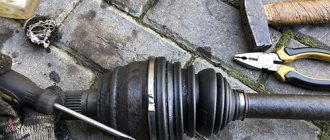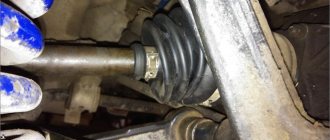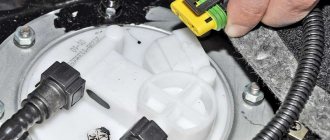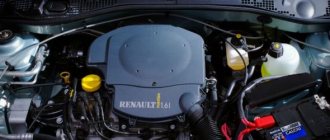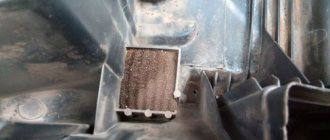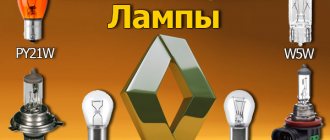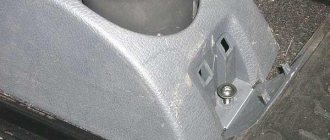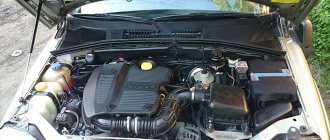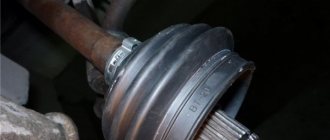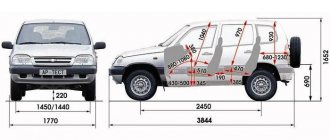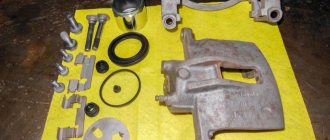Replacing the Chevrolet Niva CV joint boot - external and internal
The hinge (or “grenade”) is the most important element of a car’s transmission. Replacing the boot of the internal CV joint on a Niva Chevrolet is usually caused by the need to protect bearings and other internal mechanisms from dirt and damage.
When to replace the grenade boot on a Chevrolet Niva?
As a rule, replacing the Chevrolet Niva CV joint boot is carried out after inspecting the part and detecting damage. It could be a small hole, a crack, or a large tear. Regardless of the degree of damage to the protective cover, it must be replaced with a new one. If this is not done in time, the owner will face complex and expensive repairs.
Checking the rubber protection must be carried out regularly, since parts wear out quickly if they are constantly under load. Checking is a simple undertaking. You just need to turn the front wheels to the right or left all the way and inspect the elements. There should be no traces of oil or cracks on them.
What tools will be needed for replacement?
Before replacing, you need to prepare several tools:
- set of keys, screwdrivers;
- lift;
- wooden stands;
- puller
Of course, you need to buy lubricant and a new protective cap with clamps.
Replacement procedure
If the car owner has the skills to work under the bottom of the car, it is not necessary to completely remove the drive. There is also no need to dismantle the CV joint - the whole operation boils down to removing the hinge mechanisms. First of all, lift the car onto the pit, tighten the handbrake, and select first gear. You need to jack up the front of the Niva and remove the wheel - right or left. For safety reasons, place a wooden support under the threshold of the car.
Now you need to disconnect the hub from the suspension. You need to do the following:
- unscrew the hub nut (it is tightened with great force);
- remove the jack from under the car and install it under the ball joint;
- lift it a little, place a wooden block under the lower arm, remove the jack;
- loosen the nuts of the lower ball joint connecting the part to the steering knuckle and pull out the bolts;
- disassemble the shock absorber mount at the bottom, compress the spring as much as possible so that it does not interfere;
- move the hub mechanism to the side.
Then you will need to crawl under the car and loosen the clamps of the internal grenade case. You can even cut them off, since they will no longer be used. The inner boot must be pulled out from the outer ring, then simply cut off.
If there is a “grenade” of an old year of manufacture on the Niva, then there will be a locking ring around the perimeter of the outer clip, preventing the element from accidentally coming off. The ring needs to be pryed off with a screwdriver and removed.
To separate the inner CV joint from the structure and divide it into 2 parts, you need to pull the hub all the way to the side. Pull the shaft with the outer “grenade” and part of the inner one out from under the car. After:
- remove the elements of the inner race of the hinge: a separator with rollers (in the case of a tripoid version) or just 6 balls (Rzeppa);
- place them in a bath with kerosene, rinse thoroughly;
- put on a new boot;
- assemble the internal mechanisms of the hinge, apply new lubricant;
- install half of the “grenade” in place;
- collect everything as it was originally.
This method takes less time, but is not always feasible. Without certain skills, installing a new protective cover without removing the drive is problematic. Therefore, it is still recommended to dismantle the axle with the internal “grenade” intact. The drive from the outer CV joint will easily disengage after moving the hub with the rotary cam. The second end of the axle is fixed to the gearbox - you need to remove several nuts to remove the bracket. If necessary, the boot of the outer CV joint of the Niva Chevrolet is simultaneously replaced.
Is repair possible?
In some cases, the protective cap can be repaired. For example, if it breaks on the road, but there is no new one at hand. Restoration involves the use of rubber patches or cellophane. Both options work, they help you get to the nearest service center without the risk of ruining the CV joint.
Rubber patches must be prepared in advance. Usually they use the same ones as for a car tire. You also need to apply grenade lubricant, sealant and kerosene. The patch is glued to the boot, and for greater reliability it is filled with sealant on top. After drying, you can drive, but not for long. The restored cover must be replaced as soon as possible. It will be even better if you can carefully remove the damaged component, clean it, fill it with oil, securely fasten it with clamps, and only then install the patch.
Cellophane is used as a last resort - when the rubber protection cannot be removed. You need tape, lubricant, and a syringe. The protective cover is cleaned of dirt right on the spot and washed as much as possible. The oil is filled with a syringe through the boot into the joint. Next, the structure is wrapped in a plastic bag and with tape on top. It is advisable to use not ordinary stationery tape, but a special one - automotive, durable.
By regularly inspecting the boot, you can avoid expensive repairs. But if you do not have technical skills, it is better to contact a service center, where they will do a full diagnosis of the suspension elements. If necessary, they will change not only the cover, but also the CV joint itself.
Video on replacing Niva CV joints:
Removal and replacement process
The work is carried out using an inspection pit, overpass or lift. To replace the washer you will need the following tool:
- one socket wrench for 13 and two for 19;
- flat screwdriver;
- small hammer;
- scrap;
- chisel;
- goatee
You will also need to stock up on the following items:
- centering sleeve;
- four self-locking nuts;
- O-ring for flange mounting;
- worm clamp with a diameter of 150 mm.
To remove the intermediate shaft, you must:
- Using a 13mm wrench, unscrew the 4 nuts that secure the shaft joint housing to the transfer case flange.
- Place a 150mm diameter worm clamp onto the rubber coupling and tighten it.
- Make marks on the CV joint and the transfer case flange housing to remember their relative positions.
- Loosen the nuts holding the power unit and move it forward 15-20 mm (a crowbar will come in handy here).
- Using 19mm spanners, unscrew the nut and remove the bolt securing the coupling to the gearbox flange.
- Unscrew and remove the other three bolts.
- Move the intermediate shaft towards the gearbox and remove the hinge housing studs from the holes on the transfer case flange.
- Do the same operation with the hinge.
- Remove the intermediate shaft from the vehicle.
In most cases, the leak can be repaired. You can replace the boot or joint, flexible coupling or spline seal. After this, you need to install the intermediate shaft in place. Don't forget to install new self-locking nuts. These parts cannot be reused - they may come loose due to vibration.
Replacing the CV joint boot for Lada 2123 (VAZ 2123)
A distinctive feature of Niva cars, both the regular VAZ 2121 and Chevrolet, is the presence of CV joints on the front axle drives. In fact, the design is quite similar to any front-wheel drive VAZ.
The main symptoms of CV joint failure on Niva
As with any other car, grenade malfunctions immediately make themselves felt. And the first thing that will be a symptom is:
- the appearance of clicks when starting and suddenly stopping
- the appearance of a crunching sound when starting from a stop with the steering wheel turned all the way
- crunch even when driving straight at high speed - especially when hitting smooth bumps in the road
Do-it-yourself CV joint replacement on Niva
Many Niva owners are accustomed to entrusting such repair work to specialists at a service station, but everything can be done in a garage, having a list of necessary tools at hand.
Well, then everything is done in the following order:
- We remove the wheel by first lifting the front of the car with a jack.
- Unscrew the fastening of the ball joint to the lever to free it
- Unscrew the hub nut and remove the CV joint from the hub
- For greater accessibility, it is better to remove the drive assembly: pry the inner grenade with a pry bar and pull it out
- After this, the entire drive assembly is removed
- Clamp the drive in a vice
- Using special pliers, we free ourselves from the anther clamps (if necessary, we then replace them with new ones)
- With light blows of a hammer, we knock the desired CV joint off the drive, applying the impact force to the outer race
Usually, after a couple of light blows, the CV joint breaks down without any problems and you can replace it with a new one. Once again, it is worth noting that it is better to inspect the boot for damage and, if necessary, also replace it with a new one.
The new CV joint is driven in exactly the same way until the locking ring clicks.
It is worth noting that as a result of assembling the drives, it is necessary to push lubricant into the inside of the CV joint, such as a CV joint or lithol (as a last resort). If this is not done, wear will occur much faster than if the required amount of lubricant is available. Also, pay attention to the integrity of the protective boots of both the internal and external grenades. If you see that the boot is damaged, replacing it with a new one is mandatory.
Installation on the vehicle occurs in the reverse order of removal. Also, do not forget to install all removed parts during the repair process.
The price of a new internal CV joint is from 800 rubles, but the external one will cost almost twice as much: from 1,400 rubles. If we consider buying assembled drives, then one can cost you at least 3,500 rubles, and a pair, of course, about 7,000 rubles.
On the left is Trialli, set it and forget it. On the right is Avtovazovsky. The knock-knock-knock started when driving especially uphill and turning to the right. The sounds are getting louder. The symptom is known, we go to change it. Brief instructions for those who still doubt whether to change the studs in the bridge to bolts or not.
We remove the wheel, unscrew the lower ball joint, and use a suitable device to hang the fist with the hub-disc. I use a generator belt from Niva. I cling to the amma mount and 2 studs on the hub.
We unscrew the nut on the CV joint, remove the bushing to free up more thread length, and screw the nut back on. We tighten another nut on top and, clamping the nut onto the nut, unscrew the stud. I tried it, it turns out, even with the top nut half tightened. Photo for example.
Unscrew the ear mounting bolts.
Unscrew the ski from the stabilizer. We don't touch the cardan.
We need to unscrew the left ear and the ski so that we can twist the bridge a little when pulling out the CV joint. We rotate the right ear along the axis upward.
We pull out the CV joint, moving the bridge a little clockwise when looking from above and a little down.
It took me about half an hour to sort it out. Good luck to everyone on the road and off the road and silence in the cars)
Reassemble in reverse order. Long ball bolts fit perfectly in place of the unscrewed studs.
https://www.drive2.ru/l/6812746/
No comments yet
Checking the CV joint
First, you should jack up the car and see if the boot is cracked. If there is visible damage in it, then a large amount of dirt has probably accumulated inside, which will cause an unpleasant crunch when turning and starting with the wheels turned.
As a rule, in this case, it is enough to clean and rinse the internal parts with gasoline, lubricate them, and put them back together. In addition to lubrication, you will also need to replace the anthers with new ones. But if you operate a car for a long time with dirt inside the CV joints, this can lead to their complete failure, which is why at the slightest crunch you need to immediately sound the alarm. Do not forget that replacing a CV joint on a VAZ 2110 or any other car model will cost approximately 1,500 rubles, this cost is only for the part.
How to diagnose joint wear
There is a proven method for diagnosing joint wear. To do this, you can “start” with the wheels turned out, if at the same time you feel a clear crunch in the front part of the chassis, then they will have to be changed. To be completely sure, you can also spin the car or start with the wheels slightly turned. You will immediately feel whether the left or right mechanism crunches. If it is both, then you will have to jack up the car and determine which of them has play. If both hinges are loose, you need to prepare for significant expenses.
Signs of wear will be visible if you put the car on a jack on the side where you hear the crunching sound. Then you need to grab the drive with your hand and shake it in different directions. If you feel significant play, the bearings are definitely worn out, and you can prepare to buy a new CV joint.
A couple of tips to help prevent CV joint wear
Despite the fact that many car enthusiasts do not even suspect the presence of such a part in their car, as a rule, they themselves are the culprits of its breakdown.
It must be remembered that aggressive driving is the first reason for joint failure. In particular, these are constant sharp starts with the wheels turned out and driving in reverse with the same steering wheel position. In addition, we need to remember what roads we often have to drive on. If rough terrain is normal driving conditions, then the boots should be checked more often than usual. In addition, timely replacement of lubricant in CV joints is the key to their long-term operation.
Aggressive driving, as you know, also means sharp starts. They are the cause of overheating of CV joints, and where there are high temperatures, there is increased wear of parts, no matter what high-strength materials they are made of.
Replacing inner CV joint boots — Chevrolet Niva, 1.7 l., 2007 on DRIVE2
Yesterday I discovered that both boots of the inner CV joints were torn and the grease came out... I think this is due to the fact that I did not let the air out from under the boots when I assembled the inner CV joints, and I put a lot of lubricant in them...
this is what it looks like
It’s good that I didn’t climb into the mud, the lubricant is clean
took off the clamp and moved the torn boot
To replace the inner CV joint boot, you need to remove the wheel, the hub nut, and unscrew the three lower ball bolts; Remove the hub from the drive and hang it so that it does not interfere.
Then, on the inner CV joint, remove the large clamp from the boot, move the boot aside, pick out the large retaining ring from the CV joint; and the drive can be removed!
torn boot
between the shock absorber and the spring I was able to pull out the drive with the insides of the CV joint
However, then I still had to unscrew the bottom bolt of the shock absorber, because it was impossible to insert the drive back, the balls fell out...
preparation for washing
disassemble and wash everything in kerosene
I put on a new boot; I didn’t remove this ring from the stick, I just dragged the boot through it, silicone grease rules!
lubricate the CV joint)
By the way, there was another epic with this drive stick retaining ring...
When forcing the CV joint race onto the drive rod, this ring broke... But there was no other... I went to the store, they didn’t have such rings for 2123 drives, they gave me a 2108 drive ring... And it’s made of some kind of mild steel... When stuffing the CV joint race, the risks remain on the ring ... I don’t know how long it will take for it to fly out...
CV joint grease
I unscrewed the lower shock absorber mounting bolt to insert the drive
Then we put a large retaining ring in the inner CV joint, put on the boot and clamps.
we place the hub on the outer CV joint and screw the lower ball joint
and here again the error... there is air left inside the CV joint
I had to remove the large clamp and squeeze out the air from inside the CV joint... The same with the second wheel... And we adjust the wheel bearings! By the way, I didn’t make any marks on the CV joints, separator and balls before disassembling... well, so that later I could reassemble it the same way as it was... Because these CV joints quite fresh, installed 2 months ago, production is low...
I passed - everything is OK! no crunches...
Good luck to all)
Price: 320 ₽ Mileage: 90830 km
Page 2
Yesterday I discovered that both boots of the inner CV joints were torn and the grease came out... I think this is due to the fact that I did not let the air out from under the boots when I assembled the inner CV joints, and I put a lot of lubricant in them...
this is what it looks like
It’s good that I didn’t climb into the mud, the lubricant is clean
took off the clamp and moved the torn boot
To replace the inner CV joint boot, you need to remove the wheel, the hub nut, and unscrew the three lower ball bolts; Remove the hub from the drive and hang it so that it does not interfere.
Then, on the inner CV joint, remove the large clamp from the boot, move the boot aside, pick out the large retaining ring from the CV joint; and the drive can be removed!
torn boot
between the shock absorber and the spring I was able to pull out the drive with the insides of the CV joint
However, then I still had to unscrew the bottom bolt of the shock absorber, because it was impossible to insert the drive back, the balls fell out...
preparation for washing
disassemble and wash everything in kerosene
I put on a new boot; I didn’t remove this ring from the stick, I just dragged the boot through it, silicone grease rules!
lubricate the CV joint)
By the way, there was another epic with this drive stick retaining ring...
When forcing the CV joint race onto the drive rod, this ring broke... But there was no other... I went to the store, they didn’t have such rings for 2123 drives, they gave me a 2108 drive ring... And it’s made of some kind of mild steel... When stuffing the CV joint race, the risks remain on the ring ... I don’t know how long it will take for it to fly out...
CV joint grease
I unscrewed the lower shock absorber mounting bolt to insert the drive
Then we put a large retaining ring in the inner CV joint, put on the boot and clamps.
we place the hub on the outer CV joint and screw the lower ball joint
and here again the error... there is air left inside the CV joint
I had to remove the large clamp and squeeze out the air from inside the CV joint... The same with the second wheel... And we adjust the wheel bearings! By the way, I didn’t make any marks on the CV joints, separator and balls before disassembling... well, so that later I could reassemble it the same way as it was... Because these CV joints quite fresh, installed 2 months ago, production is low...
I passed - everything is OK! no crunches...
Good luck to all)
Price: 320 ₽ Mileage: 90830 km
The design and principle of operation of the CV joint
The animation clearly shows the principle of operation of a ball CV joint of the “Rtseppa” type. Everything is ingenious and simple. There is virtually no power loss at large joint angles. Structure of external and internal CV joints: 1 - retaining ring of the inner joint housing; 2 — protective ring of the internal hinge; 3 — internal hinge body; 4 — shaft stop; 5 - retaining ring; 6 — clip; 7 - ball; 8 - thrust ring; 9 - separator; 10 - outer clamp; 11 — lock of the internal hinge; 12 — protective cover; 13 — internal clamp; 14 — wheel drive shaft (axle shaft); 15 — protective ring of the outer hinge; 16 — outer hinge housing.
First of all, the hinge is designed to transmit driving force from the engine to the wheels of the car. The second important function is to maintain movement at different wheel planes. In simple words, when driving over a bump or hole, one of the wheels will be located higher than the second, while the movement of the car will remain unchanged.
There is no fundamental difference in the operation scheme of the CV joint. One part of the drive is attached to the engine using a wheel bearing, the second is connected to the wheels. When the gear is engaged, the engine transmits movement through the transmission, and the car moves. Each CV joint consists of an internal and external part.
Lubrication is important in the operation of a grenade. All internal parts move at high speeds, so good lubrication can reduce friction and wear on structural elements
As a rule, each hinge is covered with a rubber cap to prevent dirt from getting inside. It is worth noting that rubber protection is of great importance in the operation of the mechanism. If the boot is damaged, the lubricant comes out, dirt gets on important elements and the hinge fails.
External CV joint
The design of the CV joint is somewhat reminiscent of a driveshaft. But the latter, due to its design, cannot rotate at critical angles. This is due to the fact that the operating angle of the cardan transmission is very small, and at critical angles jerks begin, which have a detrimental effect on the gearbox.
A completely different matter is the CV joint. The design allows for a small-sized mechanism that will rotate the wheel in different planes, while maintaining a smooth ride and a comfortable ride.
The external “grenade” consists of a body and axle shaft, as well as a protective casing. There are metal bearings (balls) inside the mechanism. All structural elements are connected to each other using a metal ring. The principle of operation is simple, the mechanism rotates in different directions, the balls rotate inside the body in special grooves, and a smooth transmission of rotational motion occurs.
Inner CV joint
The principle of operation is similar to the external grenade, only due to the design features and location, the internal hinge operates at smaller degree ranges. Typically, the working angle is up to 20 degrees.
Video of the operation of the outer and inner CV joints on the drive shaft.
Article - Replacing the boot on a Chevrolet Niva from RTI-Promexport™ Barnaul
June 29, 2018
CV joint (or grenade) is a constant velocity joint. It is used in front wheel drive vehicles. Initially, they transmitted torque to the drive wheel using a conventional cardan. Car enthusiasts know that if knocking noises are heard in the front-wheel drive when turning, then most likely the CV joint is faulty or the inner boot on the Niva needs to be replaced. Grenades on the Chevrolet Niva are internal and external. Like any part in a car, hinges and mudguards have their own service life and periodically fail.
How to determine a breakdown
Most often, mudguards are to blame for problems with CV joints. Upon external inspection, ruptures are visible on them, and when rocking, play is felt. Sometimes traces of grease or dark spots are visible on the hinge, this means that the boot is torn. In this case, it is necessary to replace the CV joint boot on the Chevrolet Niva.
If the dirt cover is damaged, water and dust get inside, so the bearing itself often has to be replaced. The work can be done independently in 1.5-2 hours. To work, you will need a minimum of tools: pliers, a hammer, a screwdriver.
Process
To change the boot on a Chevrolet Niva, take sliding pliers and a screwdriver and remove the clamps from the dirt cover. Slide it along the shaft, remove the element using a hammer and a wooden block with gentle blows.
We disassemble the inner CV joint:
- Using a screwdriver, remove the retaining ring.
- We remove the clip, having previously made marks on the balls and grooves.
- Remove the large and small clamps.
- Before changing the CV joint boot on the Niva, we move the casing and cover along the shaft.
- We knock down the bearing using a hammer and a wooden block, applying rhythmic blows to the end of the cage.
- Remove the cover and casing.
- We wash all parts with gasoline.
- Apply lubricant to the joint.
- We install the CV joint and other removed parts in the reverse order.
Causes
Service life too long. If the car has driven 10 thousand kilometers without problems, then the anthers should be changed without waiting for a breakdown.
Sloppy driving. During sharp turns, fast driving “over bumps” and turning the steering wheel, the CV joint takes on the entire load. It can break at any moment, so every car enthusiast should know how to replace the boot on a Niva.
Water, dust and dirt. As a result of damage to the dirt cover, water and dust enter the CV joint. When mixed with lubricant, dirt acquires abrasive properties and leads to damage to the hinge.
Now you know how to change the boot on the Niva’s cardan and how to prevent damage. However, for quality repairs, we recommend turning to specialists.
Removal and installation of front wheel drives Niva Chevrolet
You will need: keys “13”, “17”, “27”, a wrench for the wheel nuts. 1. Disconnect the front driveshaft from the front axle gearbox (see “Removing and lubricating the Niva driveshaft”).
2. Raise the car and remove the front wheels.
3. Disconnect the shock absorbers from the lower front suspension arms.
4. Unscrew three nuts securing the bearing housings of the inner hinge of the right and left drives.
5. Remove the bolt securing the right front axle gearbox bearing cover to the front suspension cross member.
6. Unscrew the four nuts securing the suspension brackets of the front axle gearbox.
7. Unscrew the nut and remove the bolt securing the left front axle gearbox bearing cover to the front suspension cross member.
8. Raise the front axle gearbox and secure it in this position in any available way.
9. Remove the front wheel hub cap and unscrew the hub nut
The hub nut is tightened to a large torque.
Therefore, we recommend using a head with a strong knob.
10. Remove the nut and centering sleeve.
11. Compress the suspension spring by jacking up the lower arm.
Unscrew the three nuts and remove the ball joint bolts from the lever.
12. Move the steering knuckle to the side.
13. Disconnect the exhaust pipe from the exhaust manifold and exhaust gas converter and take it to the engine (this operation is not required to remove the left drive).
14. Pull the gearbox back
15. Remove the right drive
16. Remove the left drive in the same way.
17. Install the drives and all removed parts in the reverse order of removal.
When tightening the wheel hub nuts, adjust the clearance in the bearings (see “Adjusting the wheel hub bearings of Niva Chevrolet”).
Replacing the outer CV joint on a Niva Chevrolet
In Niva Chevrolet cars, the grenade is presented in the form of a constant angular velocity hinge. This name of this node comes from its similarity to a military node. It is also called CV joint; it transmits torque in the car, from the engine itself to the wheels, at different steering angles.
This element appeared at the time when front-wheel drive cars began to be produced, and before that, the transmission of torque to the wheels occurred through a conventional cardan. And since the joint was constantly under load, its service life was short, and this problem led to the creation of a special CV joint unit, which could transmit torque to the wheel at different angles when turning.
Content
Types of CV joints
This element helps to transmit torque evenly, while taking into account the fact that the wheel can be at different angles relative to the car. They come in two types:
These parts, like any other, wear out over time, so sooner or later the vehicle owner comes to the conclusion that they need to be replaced. Let's take a closer look at the reasons why replacing the outer CV joint on a Niva Chevrolet is necessary and why it fails.
- A common reason for failure is the longer service life of the part. As a rule, replacement is required after ten thousand kilometers, but replacement may be required earlier
- Driving on a broken road, sharp turns, the steering wheel is turned all the way at speed, at these moments the maximum load occurs on the CV joint
- If dust, dirt, or water gets in due to wear of the rubber boot, this also provokes a breakdown earlier than stated. Therefore, you should periodically check the condition of the protection.
Replacement
To change the outer CV joint, it is necessary to remove the grenade jet; it can only be dismantled together with the axle shaft; when the procedure is completed, the following steps must be taken:
- We clamp the removed unit in a vice
- Removing the old boot
- We knock down the CV joint with a hammer
- We clean all the existing teeth on the axle gear
- We install a new hinge on the axle
- We put the boot on and clamp it with clamps
- Putting everything in place
Quite often, Chevrolet Niva car owners resort to tuning the engine, as a result of which its power increases, thereby increasing the load on the CV joint and cardan shafts several times, and in order to avoid rapid wear of these parts, it is recommended to strengthen the shaft.
Therefore, if you know all the features of these parts, then you will always determine why one or another element failed, and you will be able to replace it at any time yourself.
Grenade replacement
Right inner CV joint close up, you can see the article number and markings
This unit consists of parts that are constantly in motion. As a result, they may burst or wear out, requiring replacement.
But this happens quite rarely, since it is almost impossible to detect damage to the boot in time. It should also be said that the cost of the CV joint is not high, and therefore it can be purchased if necessary.
Troubleshooting
You can determine the malfunction of the grenade yourself. To do this, while the car is moving, turn the steering wheel in any direction until it stops. In this case, the driver will hear a crunching sound in the area of the front wheel. In this case, you need to replace the hinge.
Video on how to determine if a grenade is faulty
Changing a grenade on a Niva Chevrolet with your own hands
To replace a grenade, you must first remove the old one. In the process, you will have to dismantle the axle shaft along with the CV joint (you can find a disassembly video on the Internet). Then the car owner must perform the following actions:
- Clamp the removed assembly in a vice.
- Remove the old boot.
- Knock the CV joint off the axle using a hammer and a socket.
- Clean all teeth on the axle gear.
- Install the new joint on the axle.
- Place the boot and secure it with clamps.
- Install the axle with CV joint on the car.
Replacing the inner and outer CV joints on a Chevrolet Niva: how to change the right and left “grenades”
Drivers had never even heard of CV joints until cars with front-wheel drive appeared on the roads. Previously, torque to the wheels from the power unit was transmitted through the driveshaft. With front-wheel drive, the drive wheels must turn - with a cardan this is impossible.
To transmit torque, they developed a CV joint (which stands for constant velocity joint). The hinge is also found on the popular Chevrolet Niva model in Russia.
CV joints on Chevrolet Niva: what are they?
The purpose of the CV joint on a Chevrolet Niva is to uniformly transmit torque to the drive wheel, regardless of its angle of rotation. According to the design features, the parts are:
It is impossible to transfer rotation to a wheel with one CV joint on a Chevrolet Niva, so there is always a pair of them in the drive. The one located near the gearbox experiences a heavier load. It is easy to distinguish - it has large dimensions compared to the outer hinge. The external unit transmits rotation to the wheel. Its dimensions are also affected by the limited space in the area of the drive wheel.
Why does a grenade break?
The “Grenade” fails for the following reasons:
- the service life of the unit has expired;
- aggressive driving style, operation in difficult road conditions;
- entry of dust and dirt into the unit.
To eliminate the risk of premature failure of the Niva Chevrolet “grenade” (especially the outer one), you need to check the condition of the protective rubber covers more often.
How to identify a malfunction
Problems with the “grenade” are indicated by unpleasant sounds that occur when turning the steering wheel. They first appear when reversing and turning the front drive wheels - a slight crunching sound is heard. Further, it will intensify even with small turns of the steering wheel. When shocks or slipping occur in the transmission, the “grenade” will have to be changed.
Replacement procedure: step-by-step algorithm
There is no point in repairing a worn-out unit, so the outer CV joint of a Niva Chevrolet is always replaced. Replacing a damaged “grenade” is a labor-intensive operation. You will need a set of wrenches, pullers, and experience in performing plumbing work.
Outer CV joint
The damaged unit is replaced using an axle shaft with grenades removed from the vehicle. The body is raised with a car jack, a reliable stand under the car and wheel chocks are installed. This helps protect the repairman from possible injuries. Before lifting the car body, loosen the hub nut. You will need a head and an extension for the key. Next, you need to remove the wheel and unscrew the lower mount of the front shock absorber. Take it to the side and secure it with improvised means. Also unscrew the bolts on the ball joint.
Then they completely remove the nut on the hub and, pulling it towards themselves, take out the “grenade”.
The outer joint can be replaced without removing the axle shaft.
Release the boot mounting clamp and move it as far as possible on the axle shaft. A hammer with an extension is used to hit the body of the “grenade” until it is removed from the axle shaft. Before installing a new part, be sure to change the retaining ring on the axle shaft, since it is disposable. Installing the hinge is done in the reverse order.
Inner CV joint
This faulty unit on a Chevrolet Niva can only be replaced after the axle shaft with constant velocity joints has been completely removed. The “ear” and skis are released, which will allow you to rotate the bridge when removing the axle shaft. For ease of operation, the dismantled axle shaft with “grenades” should be clamped in a vice. Replacing the internal CV joint of a Niva Chevrolet occurs as follows:
- Remove the clamps securing the protective boots and move them as far as possible.
- Use a hammer and extension to remove the damaged “grenade”. A few blows are enough to dismantle the faulty part.
- Before installing a new hinge, carefully clean the splines and install a new retaining ring, since it is disposable.
- A new CV joint is installed on the axle, the protective cover is additionally filled with lubricant, and the boot is clamped with a clamp.
The axle shaft with new grenades is assembled and mounted in the reverse order. The process is fully presented in the video:
It will be possible to extend the service life of constant velocity joints if you monitor the condition of the protective covers on the grenades, avoid bad roads and use only high-quality spare parts.
Causes and signs of grenade failure
A high-quality CV joint is a durable and reliable part of a car’s chassis, but only if the operating rules are followed. The special anthers that protect the units are designed to eliminate the adverse effects of external factors: they protect the CV joints from dirt, dust and moisture.
The performance of the part largely depends on the condition of the anthers. The slightest damage to them when driving on bad roads with numerous potholes ends with contaminants getting inside the CV joint. Under the influence of dirt and moisture, the internal lubrication of the hinges becomes unusable, resulting in increased friction, which leads to breakage of the part.
Another reason for problems with the part is illiterate, extreme driving. Sharp starts with twisted wheels or slipping, and other increased loads on the chassis force the joints to work to the limit. The risk group includes cars with overclocked engines. Standard drives are not designed to transmit additional torque, so their service life is dramatically reduced.
The most vulnerable part of a grenade is the boot
A CV joint can quickly break due to the fault of the car manufacturer. The use of low-quality metal or violation of production technology sharply reduces the quality of the part. The car owner is unable to influence the operation of the hinge, since the fault for its failure lies entirely with the car manufacturer.
You can understand that the CV joint is faulty by the following signs:
- Crunching noise when turning. The assembly begins to crunch due to dirt getting inside and removing lubricant from its connections.
- Jerking when starting to move, accelerating or decelerating the car.
- Vibration at speed, especially when turning.
Diagnostic methods
A characteristic sign of problems with the operation of the mechanism is damage to the boot. If even small cracks or loose clamps are found on the protection, it is worth checking the condition of the unit. Experienced car owners and mechanics advise checking the condition of the boots after every 5–7 thousand mileage.
Experts recommend using one of the following methods for diagnosing the malfunction yourself:
- The car is placed on a lift and the first gear is turned on. A faulty hinge will immediately produce a characteristic crunch.
- Turn the steering wheel all the way, start the engine and drive off. A crunch may appear at the beginning of acceleration.
- Listen to sounds when driving over bumps or picking up speed.
- A clear sign of a joint malfunction is increased play. To check the condition of the part, take the internal hinge at the output of the external drive and swing it: a play of one and a half tens of millimeters indicates a breakage of the part.
Timely diagnostics will help you avoid problems with your car.
This is interesting: What is the ground clearance of the Kia Rio hatchback
Replacing the Boot of the Outer CV Joint Niva Chevrolet ~ AUTOINTERLINE.RU
All about the CV joint and how to dismantle and install it
Before you start talking about any breakdown, you need to give a specific definition of one or another part that will be repaired in the future. This also applies to repairing the CV joint. This part is one of the components of the box. In general, CV joint is an abbreviation that stands for: Constant Angular Velocity Joint. This part is popularly called a “grenade”. The reason for this name is simple; this car part has a shape that is quite reminiscent of an explosive object.
The CV joint itself transmits the torque of the motor, which is transmitted from the gearbox to the drive wheels (in most cases, the front wheels). Due to this chain, a very rhythmic rotation is carried out, and this despite the fact that there is an angle between the shafts that connect it.
There are two types of CV joints in the car - external and internal. Naturally, someday there comes a time when the service life comes to an end and it is necessary to replace this hinge with a new one. But how can you find out that it’s worth changing and, if so, how to do it?
Why is it necessary to replace the CV joint on a Chevrolet Niva and how to determine it?
The wear of the CV joint is determined quite easily. You need to drive a circle, turning the steering wheel to the very end, to the right or to the left. During such driving, this part experiences a critical load, which is precisely what is necessary to determine breakage or wear.
So, if it really is worth changing, then when turning, a crunching sound will be clearly heard - this will be a signal that the part should be changed. In this case, it is always advisable to inspect two hinges at once - first making a circle clockwise, and then counterclockwise. If a crunching sound is heard in both directions, then both joints need to be replaced.
How to change CV joint boots on Niva yourself
Independent replacement of CV joint boots on Niva and Chevrolet Niva. The simplest way.
Replacement of the front left outer and inner CV joint at the Niva
Help for the project... Replacement of the front left outer and inner CV joint at the Niva.
In addition to all of the above, it should be noted that sometimes instead of a crunch you can hear a knock - this also means that there is a problem with the hinges. You can also check for breakage by shaking the shaft by hand and if play is noticed, this will definitely signal a breakage and exit from the explication. By the way, the seriousness of the whole situation when it is necessary to change the hinges is further emphasized by the fact that when replacing it, absolutely all components will have to be changed, there is no other way.
Causes of failure
There are not many reasons why you need to replace the CV joint on a Chevrolet Niva. A breakdown can occur due to extremely careless driving, which of course never leads to anything good. Also, the cause may be the boot, which has already become old and cracked, which is why dirt gets into the CV joint, which under no circumstances should be there.
It is worth noting that the situation with a cracked boot may mean that you just need to install a new one, and the hinges may be fine, but this happens extremely rarely and most often the whole problem lies in the breakdown and wear of the CV joint.
Repair stages
- Clamp the shaft in a vice
- At the inner CV joint, it is necessary to remove the outer and inner clamp
- Slide the cover protecting against dirt and turn it inside out
- Using a drift and applying maximum effort to the joint cage, knock out the inner CV joint
We do the same with the outer hinge.
- Remove both the inner and outer clamp from the outer hinge
- We slide the dirt cover and turn it inside out
- Using only a drift, we direct maximum force onto the holder and knock down the CV joint
Nuances that are important when installing new hinges
Thus, having removed the old, worn and no longer useful hinges, you can begin installing new ones. You can replace the CV joint on a Chevrolet Niva in exactly the same way, using the steps described above, only doing them in reverse. At the same time, it is worth considering some nuances and features that are important to know when installing new CV joints.
- First of all, you need to carefully ensure that no dirt gets into the new hinges.
- Secondly, you need to remember that when replacing hinges, you must also change the clamp of the covers that protect them from dirt. The reason is simple - all such clamps are disposable. True, we must not forget that the new clamps must have the same design as the old ones.
Let's start work.
Replacing the outer CV joint: how to do it?
Before starting work, be sure to install the Niva on the handbrake and insert wheel chocks under the rear wheels.
1. Loosen the wheel nuts, place the car on a jack and remove the wheel.
2. Place a secure support under the lower arm. Lower the jack and the lever will compress.
3. Remove the three bolts securing the lower ball joint and unscrew the nuts.
4. Knock the chrome hub cap through a wooden block and unscrew the nut. Make sure that the hub does not rotate; to do this, you can install some kind of stop under the wheel stud. A hammer is ideal.
5. Remove the cone washer.
6. Grasp the bottom of the brake disc and pull it towards you, then move it to the side. At the same time, the grenade axis should be removed.
The Niva CV joint has been released. You need to place it on the bottom cup in any place convenient for you.
Replacement of the front left outer and inner CV joint at the Niva
Help the project. Replacement
near the field of the front left
CV joint
, outer and
inner
.
Replacing the inner right and left CV joints Niva 2121 part-1
Video on the topic Do It Yourself CV16013 Grenade ( CV joint
) Niva internal
Fenox right 2121
21212215057 Grenade (
CV joint
) Niva.
Next, your task is to turn the CV joint and find a comfortable position in order to grab the clamp tabs with pliers. Having grabbed the clamp, you should squeeze it well, bend the hook and dismantle it. Leave marks on the car shaft, as well as on the grenade body. This is done so that later, when you put the part back in place, you assemble everything exactly as it was before the repair. When the boot is released, move it away from the grenade.
Now you need to get the wire type retaining ring on the CV joint housing. You can feel it with your finger and, using a screwdriver, pry it off at the break in the ring and remove it.
Grasp the shaft firmly and pull the CV joint of your Niva out of the body.
If you decide not to change the lubricant, you can put the spare part in a plastic bag and wrap it well to avoid dirt and loss of balls, which are attached only by good lubrication.
Varieties
SR as a suspension part began to be used on cars from the mid-20th century. Thanks to the unit, it became possible to simultaneously rotate and control the rotation of the wheels at an angle of up to 70 degrees. In the automotive industry, four technical solutions for components are used:
- cam;
- tripoid;
- ball;
- twin cardan shafts.
All these types are united by the basic design, which is a rigidly connected body and holder. The car's joints are also divided into:
- internal, rotating up to 20 degrees;
- external, more mobile and transmitting without power losses.
The part works according to the following principle.
- There are grooves on the surface of the inner race. Their number is the same as the number of bearings inside it.
- The cage is held in place by bearings that separate the housing and the cam.
- The bearings move along the path of the smaller diameter of the fist and the larger diameter of the housing.
- This creates a rotational impulse that transmits torque to the driven shaft.
If you change the angles connecting the axle shafts, the bearings begin to move inside the grooves. This is how torque is transmitted.
Part Features
Constant velocity joints - these elements were created specifically for front-wheel drive vehicles; previously, torque was transmitted to the wheels using a simple cardan. Due to the large load on the hinge, the service life of the part was very short. To avoid such a situation, this node was created.
An outer CV joint is needed to transmit torque evenly when the wheel is at different angles. CV joints can be both external and internal.
There are certain parts in the assembly that are constantly moving, so often the parts burst or completely wear out, and this requires their urgent replacement. Repair of the device is carried out when damage to the boot is detected in time, when dirt, dust and other substances do not have time to penetrate inside the grenade.
To identify a breakdown on a Niva, turn the steering wheel all the way in any direction while driving. If there is a problem, then you will hear a characteristic creaking sound in the area of the front wheel. During the repair work, you should determine how many hinges need to be changed - one or two at once. Professionals advise implementing the procedure comprehensively.
Dismantling the drive assembly on a Niva 2121 car
As for the repair procedure, we present the main points below:
- First of all, we lift the car with a jack (it is also advisable that it is in the inspection hole).
- Using a screwdriver and a hammer, knock off the protective cap of the hub nut and unscrew it.
- Using a 13mm wrench, unscrew the nuts securing the ball joint to the steering knuckle.
Now you can remove the drive shaft from the Niva's front wheel hub. And to remove
/replace external
CV joint, remove the retaining ring.
To release the internal one, you must first unscrew the three nuts securing the pressure plate.
- Then we pry up the plate with a screwdriver or a sharp chisel and pull out the inner CV joint from the front axle gear housing.
- Since the space between the shock absorber and the front suspension spring is minimal, it is not very convenient to pull out the drive assembly, so it can be disconnected.
- If necessary, defective CV joints are knocked down and new ones are installed in their place in the reverse order.
- It is imperative to apply a lubricant, such as a CV joint, to each of the grenades and securely fix the boot clamps.
- The assembled drive is installed on the Niva in the reverse order.
Which to choose
Depending on the year of manufacture, the Niva 2121 can be equipped with CV joints with 22 or 24 splines. Before 2002, the first version was distributed, after 2002 – the second. According to another version, 22-spline “grenades” were common until 2007.
The surest way to determine the type is to remove the hub washer and count by hand.
Operating experience shows that the best quality “grenades” for the Niva are produced by AvtoVAZ; also, if you are confident in the origin of the product, it makes sense to pay attention to the products of CORAM and Pilenga .
How to extend service life?
To prevent the rubber covers of CV joints from cracking and bursting longer, you should follow simple rules:
- When installing the boot, apply lubricant to the inside of each fold.
- Apply mobile phone or silicone sealant diluted with white spirit to the outer surface of the covers.
- In severe frosts, leave the car in the parking lot, having first leveled the steering wheel. This reduces the load on the tires.
If cracks appear on the boot, do not try to restore it. Immediately replace the part and change the lubricant in the joint. This approach allows you to extend the life of CV joints.
What is a node
The name CV joint itself is an abbreviation for the phrase constant velocity joint.
The node faces the following tasks:
- Make the transmission of rotating torque from the engine to the wheels of the drive drive uniform and without loss of power.
- Reduce the load on expensive parts that rotate to move the car: shaft, gear, etc.
- Reducing the level of vibration when moving vehicles.
Modern front-wheel drive cars and some all-wheel drive “horses” are equipped with such homokinetic joints. The manufacturer guarantees the same duration of operation of the unit and the vehicle itself, provided that the CV joint is serviced and driven carefully. That is, if you drive carefully and periodically properly care for the part, it will last for the entire life of the vehicle.
The fulfillment of the first point depends only on the personality of the owner, his desire to monitor the technical and sanitary condition of the car. But the implementation of the second point on most domestic roads is sometimes simply impossible. And sooner or later the grenade (another name for the unit, which arose due to its external resemblance to a military projectile) fails. It is necessary to replace the internal or external CV joint on a Chevrolet Niva or on another car with a front-wheel drive and all-wheel drive design solution.
Basic malfunctions of the Chevy drive grenade
There are 4 main signs that the constant velocity joint needs to be replaced or repaired:
- A crunching sound when driving slowly when turning, which intensifies as the wheel angle increases.
- Knocks or crunching sounds during a sharp (or not so sharp) start.
- Play in the hinge. It can be determined by shaking the axle shaft with your hands.
- Jerks when accelerating the car.
Malfunctions of CV joints occur as a result of manufacturing defects, incorrect installation of a part, lack of lubrication, driving at high speed over potholes, or natural wear of rubbing parts.
Important! Internal and external constant velocity joints wear out especially quickly when the boot is damaged. In this case, lubricant leaks from the CV joint, and instead the bearings are filled with abrasive particles of sand and dirt.
Checking the hinges is carried out in three stages:
- Turn the steering wheel completely and try to move away slowly. If a crunching sound is heard, it is necessary to change the “grenade”. In this case, the sound comes from the side where there is a problem.
- Raise the car on a lift or hang out the wheel from which you can hear a crunching sound. Visually check the integrity of the boot and make sure there is no play by shaking the axle shaft with force by hand.
- Raise both wheels of the front axle and engage reverse gear. A crunch indicates the need to replace the grenades.
If a breakdown is detected, the parts must be replaced with new ones.
